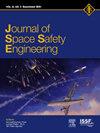太空任务太阳能电力推进的叙述性回顾:技术进步、市场机会、地缘政治考虑和安全挑战
IF 1.7
Q3 ENGINEERING, AEROSPACE
引用次数: 0
摘要
太阳能电力推进(SEP)是一种先进的技术,非常适合于需要高效率和低推力推进的长时间空间任务。SEP系统利用太阳能电池阵列驱动的电动推进器,通过转换机载电力来产生推进力。本综述全面分析了现有的和新兴的推进器技术,包括电热(ET)、静电(ES)和不断发展的电磁(EM)推进器,同时考虑了影响推进器选择的任务特定因素,如功率可用性、推进剂选择和航天器质量。SEP系统的性能在很大程度上取决于太阳能电池阵列,通常使用III-V多结太阳能电池,与钙钛矿电池、聚光光伏电池和硅异质结电池等替代品相比,它们提供了优越的阳光转换效率。尽管SEP具有效率高、任务持续时间长和可靠性等优势,但它也面临着挑战,包括对大型太阳能电池阵列的要求和对阳光的依赖。然而,正在进行的研究继续增强SEP技术,使其对未来的空间探索和科学任务越来越重要。SEP的市场前景是有希望的,其重大的地缘政治影响突出了在空间事业中加强国际合作的必要性。太阳能电力推进为卫星和航天器的运行提供了显著的好处,但也带来了安全挑战。避免碰撞、辐射防护、羽流相互作用和报废处理是至关重要的。利益相关者之间正在进行的研究和合作对于制定有效的安全协议和监管框架至关重要。本文章由计算机程序翻译,如有差异,请以英文原文为准。
A narrative review of solar electric propulsion for space missions: Technological progress, market opportunities, geopolitical considerations, and safety challenges
Solar Electric Propulsion (SEP) is an advanced technology ideally suited for long-duration space missions requiring high efficiency and low-thrust propulsion. SEP systems generate propulsion by converting onboard electricity, using electric thrusters powered by solar arrays. This review offers a comprehensive analysis of both established and emerging thruster technologies, including electrothermal (ET), electrostatic (ES), and the evolving electromagnetic (EM) thrusters, while considering mission-specific factors such as power availability, propellant choice, and spacecraft mass that influence thruster selection. The performance of SEP systems largely depends on solar arrays, typically utilizing III-V multijunction solar cells, which offer superior sunlight conversion efficiency compared to alternatives like perovskite cells, concentrated photovoltaics, and silicon heterojunction cells. Despite SEP's advantages—such as high efficiency, extended mission duration, and reliability— it faces challenges, including the requirement for large solar arrays and reliance on sunlight. However, ongoing research continues to enhance SEP technology, making it increasingly vital for future space exploration and scientific missions. The market outlook for SEP is promising, and its significant geopolitical implications highlight the necessity for stronger international collaboration in space ventures. Solar electric propulsion offers significant benefits for satellite and spacecraft operations but also poses safety challenges. Addressing collision avoidance, radiation protection, plume interactions, and end-of-life disposal is crucial. Ongoing research and collaboration among stakeholders will be essential for developing effective safety protocols and regulatory frameworks.
求助全文
通过发布文献求助,成功后即可免费获取论文全文。
去求助
来源期刊

Journal of Space Safety Engineering
Engineering-Safety, Risk, Reliability and Quality
CiteScore
2.50
自引率
0.00%
发文量
80
 求助内容:
求助内容: 应助结果提醒方式:
应助结果提醒方式:


